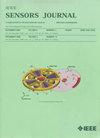基于织构弹性摩擦副压力控制的电连接器保丝力指尖传感器
IF 4.3
2区 综合性期刊
Q1 ENGINEERING, ELECTRICAL & ELECTRONIC
引用次数: 0
摘要
护线力是评价电连接器插线可靠性的重要指标。目前测量这种力的方法主要依赖于基于弹簧的测功机,这种测功机由于尺寸大且缺乏数字测试能力而受到限制。本文提出了一种通过控制金属丝与安装在指尖上的织构橡胶摩擦副之间的临界摩擦力而产生的保持力传感器。采用实验标定和机器学习相结合的方法,建立了摩擦副法向压力与导线保持力之间的转换模型。结果表明,该指尖传感器在2 ~ 16 n的保持力范围内,保持力的相对测试误差小于8%,传感器的决定系数${R}^{{2}}$优于0.908。经过1000次保持力测试,传感器的测试误差仍能保持在10%以内,表明该传感器具有良好的长期性能稳定性。本文章由计算机程序翻译,如有差异,请以英文原文为准。
A Fingertip Sensor for Wire Retention Force Test of Electrical Connector Using Pressure Control on Textured Elastic Friction Pair
Wire retention force is an important indicator for evaluating the reliability of wire insertion in electrical connectors. Current approaches to measure this force are mainly relied on spring-based dynamometers, which are limited by their large sizes and lack of digital testing capabilities. Herein, this article proposes a retention force sensor by controlling the critical friction force between the wires and textured rubber friction pair installed on fingertip. A conversion model between the normal pressure applied to the friction pair and the wire retention force was established, by combining experimental calibration and machine learning methods. Results show that the relative testing error of retention force using this fingertip sensor is less than 8%, and the coefficient of determination ${R}^{{2}}$ of the sensor is better than 0.908 within the retention force range of 2–16 N. After 1000 cycles of retention force testing, the testing error of sensor can still be maintained within 10%, indicating that the sensor has good long-term performance stability.
求助全文
通过发布文献求助,成功后即可免费获取论文全文。
去求助
来源期刊

IEEE Sensors Journal
工程技术-工程:电子与电气
CiteScore
7.70
自引率
14.00%
发文量
2058
审稿时长
5.2 months
期刊介绍:
The fields of interest of the IEEE Sensors Journal are the theory, design , fabrication, manufacturing and applications of devices for sensing and transducing physical, chemical and biological phenomena, with emphasis on the electronics and physics aspect of sensors and integrated sensors-actuators. IEEE Sensors Journal deals with the following:
-Sensor Phenomenology, Modelling, and Evaluation
-Sensor Materials, Processing, and Fabrication
-Chemical and Gas Sensors
-Microfluidics and Biosensors
-Optical Sensors
-Physical Sensors: Temperature, Mechanical, Magnetic, and others
-Acoustic and Ultrasonic Sensors
-Sensor Packaging
-Sensor Networks
-Sensor Applications
-Sensor Systems: Signals, Processing, and Interfaces
-Actuators and Sensor Power Systems
-Sensor Signal Processing for high precision and stability (amplification, filtering, linearization, modulation/demodulation) and under harsh conditions (EMC, radiation, humidity, temperature); energy consumption/harvesting
-Sensor Data Processing (soft computing with sensor data, e.g., pattern recognition, machine learning, evolutionary computation; sensor data fusion, processing of wave e.g., electromagnetic and acoustic; and non-wave, e.g., chemical, gravity, particle, thermal, radiative and non-radiative sensor data, detection, estimation and classification based on sensor data)
-Sensors in Industrial Practice
 求助内容:
求助内容: 应助结果提醒方式:
应助结果提醒方式:


